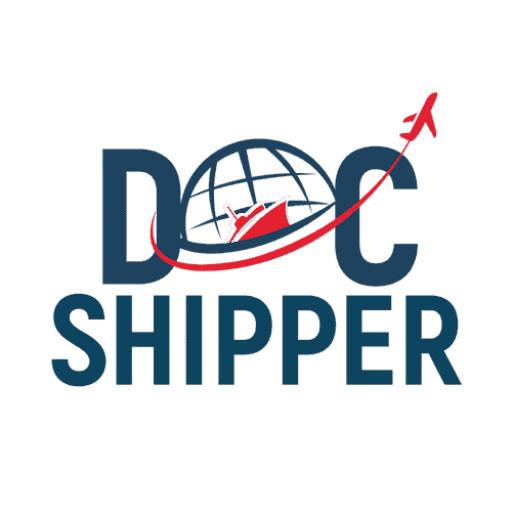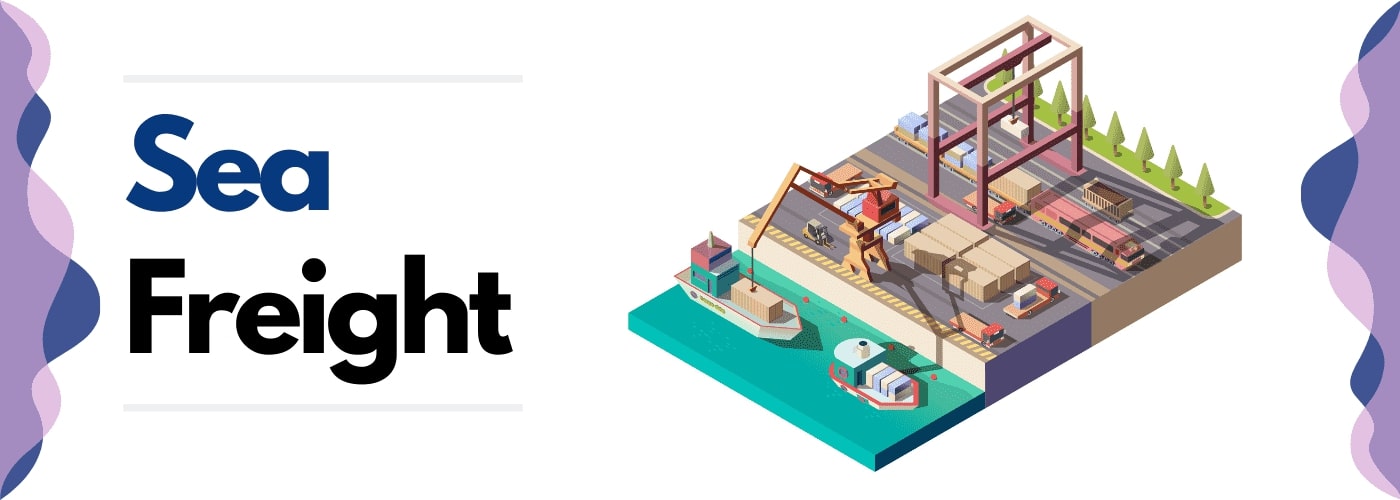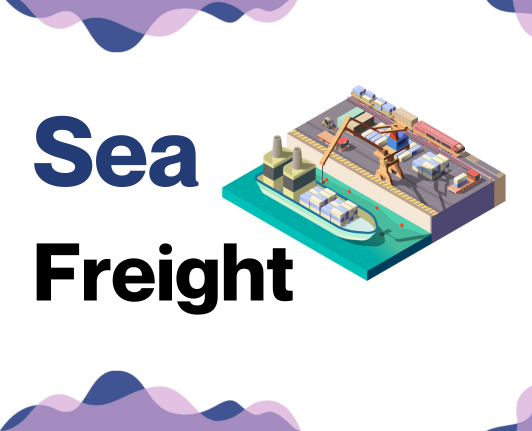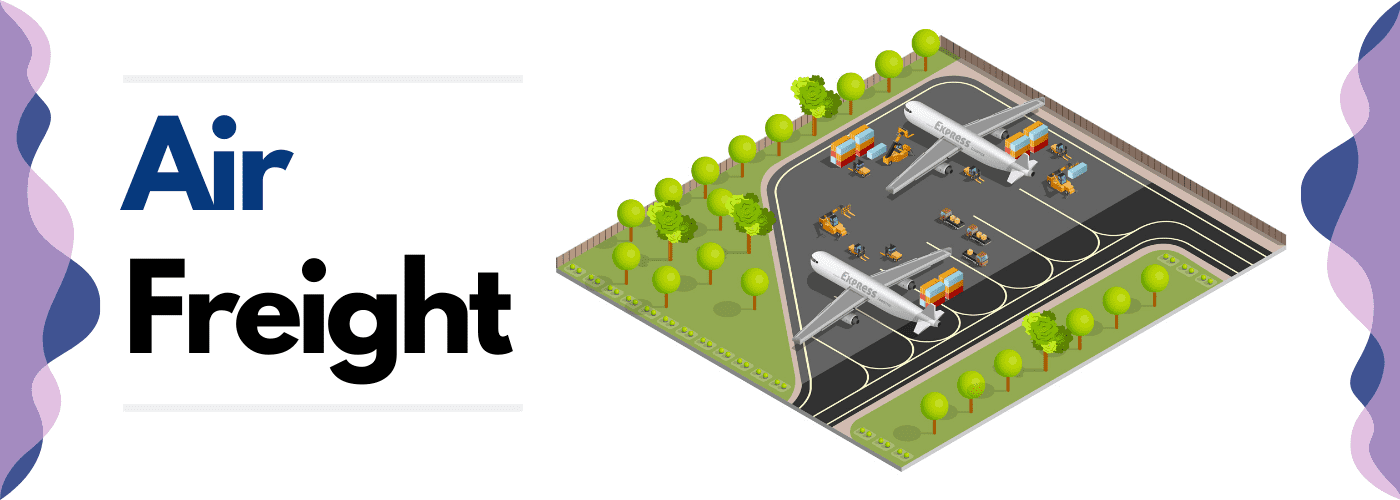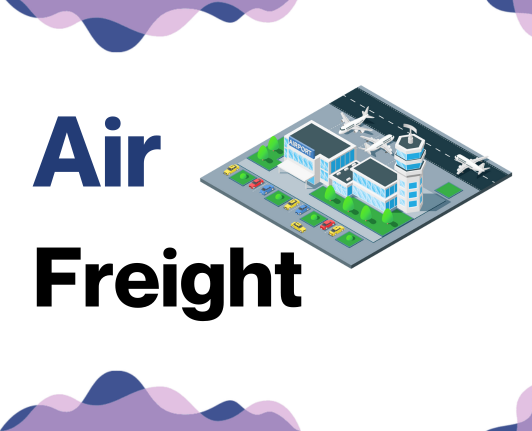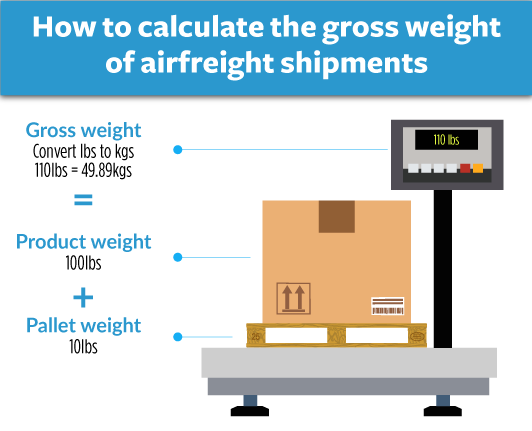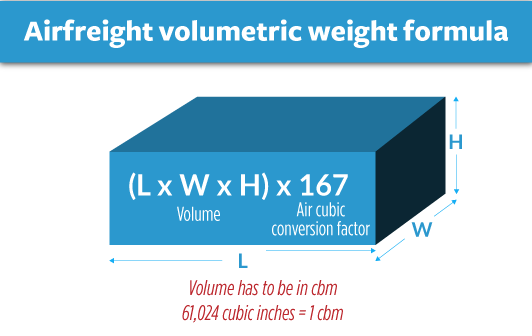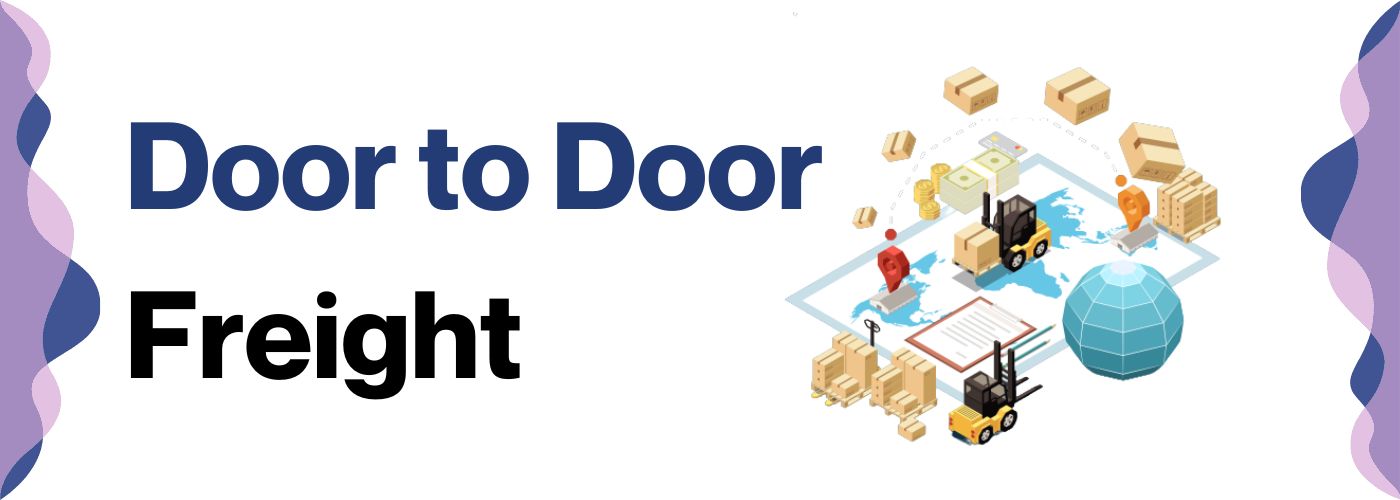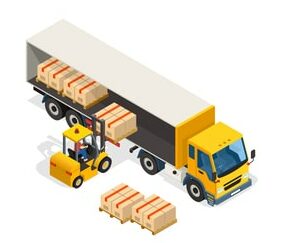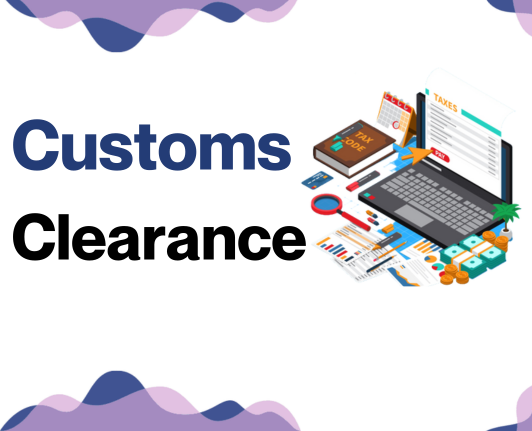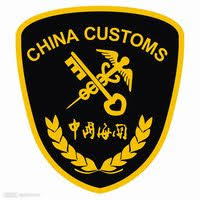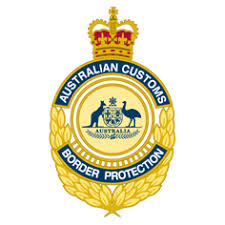We will focus on the logistics of this specific shipping route and highlighting potential challenges to watch out for. If the process still seems overwhelming after reading this guide, DocShipper is here to manage it for you. With our extensive experience in international freight forwarding, we ensure a seamless, stress-free shipping experience by handling every detail for you.
Which are the different modes of transportation between China and Australia?
Imagine trying to send a package from Beijing to Sydney, a journey crossing over 5,500 miles. It's like choosing a path on a massive board game, with sea, air, road, and rail serving as potential routes. The winner is the method that provides the perfect balance of cost, time, reliability, and cargo type.
Ocean and air freight become our chess pieces in this game due to long distances and international borders. Getting a handle on these options helps you strategize your shipping game between these two far-flung locations. Choose wisely: your business win depends on it.
How can DocShipper help?
Looking to ship goods from China to Australia? At DocShipper, our expert team can simplify the process for you, ensuring seamless customs clearance and timely delivery. From organizing transportation to handling administrative matters, we've got you covered. Got any questions? Our consultants are just a call away. Contact us today for a quick, free estimate in under 24 hours.
DocShipper Tip: Sea freight might be the best solution for you if:
- You are shipping large volumes or bulky items, as sea freight offers the most space at a cost-effective rate.
- Your cargo doesn't have an urgent deadline, as sea freight typically has longer transit times compared to air or rail.
- Your shipping routes are between major ports, allowing you to leverage the extensive global network of sea shipping lanes.
Sea freight between China and Australia
Trade between China and Australia is a thriving narrative in the global economy, traversing the bustling lanes of ocean shipping. Anchored by strategic cargo ports, such as Shanghai and Ningbo in China, connecting with key Australian ports like Sydney and Fremantle, sea freight often becomes the go-to reality for businesses dealing in high-volume goods. For such trade partnerships, the allure of cost-effectiveness often overshadows the tide of time it takes.
Yet, the journey isn't always smooth sailing. Businesses importing or exporting goods frequently grapple with intricate shipping procedures, meandering through a tapestry of potential mistakes. With this guide, we aim to be your trusted compass, pointing towards best practices and specifications to streamline your shipping experience.
Understanding port protocols, containers specifics, custom duties, and more, can shift your ship from turbulent waters into smooth cruising in the oceanic expanse of Asia-Pacific trade. So, let's set sail and explore the seascape of shipping between China and Australia.
Main shipping ports in China
Port of Shanghai
Location and Volume: Located at the middle of the 18,000km-long Chinese coastline, the Port of Shanghai plays a key role for the eastern route shipping, handling a staggering volume of 47.03 million TEUs.
Key Trading Partners and Strategic Importance: The primary trading partners are the USA, Europe, and East Asia. In terms of strategic importance, it's worth noting that this port is the world's busiest port by cargo tonnage.
Context for Businesses: If your business is looking to tap into vibrant Asian markets or even the global scene, the Port of Shanghai offers robust connectivity and huge cargo handling capacity.
Port of Shenzhen
Location and Volume: Situated in the Pearl River Delta in China’s Guangdong Province, the Port of Shenzhen boasts a yearly shipping volume of up to 30 million TEUs.
Key Trading Partners and Strategic Importance: It’s a major trading point for China with partners such as Hong Kong, the United States, and Europe. It’s one of the fastest-growing container ports globally.
Context for Businesses: Given its robust growth and strategic location, businesses aiming to penetrate Asian markets, particularly China and Hong Kong, would find Port of Shenzhen an attractive logistics point.
Port of Ningbo-Zhoushan
Location and Volume: Located in the Zhejiang province, the Port of Ningbo-Zhoushan handles a volume of 33 million TEUs.
Key Trading Partners and Strategic Importance: The key trading partners are the US, the EU, and the ASEAN countries. As the world’s largest port by cargo tonnage, it’s strategic for shipping iron ore, crude oil, and coal.
Context for Businesses: If your business involves raw materials such as iron ore or even oil, the Port of Ningbo-Zhoushan would be a very strategic shipping point.
Port of Guangzhou
Location and Volume: Located on the Pearl River, the Port of Guangzhou handles up 24.18 million TEUs.
Key Trading Partners and Strategic Importance: Its primary trading partners are Taiwan, South Africa, Australia, and Southeast Asian countries. Known as a vital infrastructure for the comprehensive transport network of Guangdong province, it’s a significant port for comprehensive foreign trade.
Context for Businesses: For businesses with operations in Southeast Asia and specific African countries, this port provides an advantageous logistical point with its extensive network.
Port of Qingdao
Location and Volume: Located on the Yellow Sea, the Port of Qingdao manages around 25.75 million TEUs.
Key Trading Partners and Strategic Importance: The primary trading partners are the United States, Japan, and South Korea. The port is a globally important liaison for trading commodities and oil.
Context for Businesses: If your business is involved in commodity trade and requires strong links with the US, Japan or South Korea, Qingdao provides a strong logistical option.
Port of Tianjin
Location and Volume: Located on the western shore of the Bohai Bay, the Port of Tianjin handles 20 million TEUs.
Key Trading Partners and Strategic Importance: The port serves as a trading hub with strong connections to South Korea, Japan, and Germany. It's also the maritime gateway to Beijing.
Context for Businesses: Businesses that require strong logistic connections with Beijing will find the Port of Tianjin to be an invaluable asset due to its close proximity and robust infrastructure.
Main shipping ports in Australia
Port of Melbourne
Location and Volume: Located at the mouth of the Yarra River, this port is the largest container and general cargo port in Australia, with a shipping volume of 2.88 million TEUs.
Key Trading Partners and Strategic Importance: The port has a significant strategic importance as it is the primary container port of Victoria handling over a third of the nation’s container trade. Its key trading partners include China, USA, and New Zealand.
Context for Businesses: If you are looking to expand your business to the southern part of Australia, the Port of Melbourne could be a vital part of your logistics due to its extensive trade links and advanced infrastructure.
Port of Sydney
Location and Volume: Located in the heart of Sydney, this port is essential for the regional trade of New South Wales, with a shipping volume of 2.5 million TEUs.
Key Trading Partners and Strategic Importance: This port holds strategic importance due to its intra-regional trades, with key partners being China, the USA, and Japan.
Context for Businesses: If your goal is to tap into the thriving markets of eastern Australia, the Port of Sydney’s advanced facilities and strategic location could be crucial to your shipping strategy.
Port of Brisbane
Location and Volume: Located on the lower reaches of the Brisbane River, this is Queensland's largest cargo port, with a shipping volume of around 1.4 million TEUs.
Key Trading Partners and Strategic Importance: This port is strategically significant due to its coal exports, with key trading partners particularly prevalent in Asia, including Japan and China.
Context for Businesses: For businesses that are focused on commodities and wish to engage with Asian markets, the Port of Brisbane is vital due to its vast coal exporting operations.
Port of Fremantle
Location and Volume: Situated at the mouth of Swan River, this port is the major gateway for trade to and from Western Australia, with a shipping volume of approximately 750,000 TEUs.
Key Trading Partners and Strategic Importance: The port plays a strategic role in facilitating trade with Malaysia, Singapore, and China.
Context for Businesses: If you are seeking to penetrate the vibrant markets of Western Australia, the Port of Fremantle's extensive connectivity can be instrumental to your shipping strategy.
Port of Adelaide
Location and Volume: Located on the eastern shores of Gulf St Vincent, this port is South Australia's primary harbor managing almost 450,000 TEUs annually.
Key Trading Partners and Strategic Importance: The port has a significant strategic importance for car exports and wheat shipments, with key trade partners being Asian countries like China, India, and Japan.
Context for Businesses: If you're in the automotive or agricultural industry, the Port of Adelaide could be a key part of your logistics chain due to its specific focus on car and grain export.
Port of Darwin
Location and Volume: Located at Frances Bay in the Northern Territory, this port is Australia's closest to Asia, handling around 250,000 TEUs per annum.
Key Trading Partners and Strategic Importance: This port holds strategic importance due to its proximity to Southeast Asia, primarily servicing trades with Singapore and East Timor.
Context for Businesses: If you aim to diversify into Southeast Asian markets, the Port of Darwin's location can offer your logistics a unique advantage.
Should I choose FCL or LCL when shipping between China and Australia?
When shipping between China and Australia, you're faced with a strategic decision: FCL (Full Container Load) or LCL (Less than Container Load). This isn't just about saving cents on the dollar - it's a decision that shapes the efficiency of your entire freight journey.
Get ready to dive into the specifics of these two sea freight options and understand how they can adapt to your unique shipping requirements, influencing key factors like cost, delivery time, and overall success. This guide aims to equip you with the necessary insights so you can make the most pragmatic choice for your business.
LCL: Less than Container Load
Definition: LCL (Less-than-Container-Load) shipment is a mode of ocean freight where several shipments from different shippers are consolidated into one container.
When to Use: LCL proves to be the more cost-effective and flexible solution when the volume of your cargo is low. When your cargo is less than approximately 13 to 15 CBM (cubic meters), specifically, LCL becomes a preferable option.
Example: For instance, let's say a Perth-based furniture manufacturing business wishes to import a small quantity of specialty wood from China. Since the order volume is quite small, employing a full container load (FCL) would result in needless expense and waste of space. In this scenario, the business could opt for an LCL shipment to minimize costs and improve efficiency.
Cost Implications: LCL freight may bear additional costs such as consolidation and deconsolidation fees. But remember, these are usually less than the price of renting an entire container that isn't fully utilized. Therefore, for shipments smaller than about 15 CBM, you can save money with an LCL option.
FCL: Full Container Load
Definition: FCL (Full Container Load) shipping is a type of freight transport where a goods consignment from one shipper fills up an entire FCL container, typically 20'ft or 40'ft in size.
When to Use: This alternative is primarily suitable when your cargo exceeds 13 to 15 CBM (cubic meters). FCL shipping is favorable for larger shipments due to lower costs per unit and heightened security, as the container is sealed at origin and remains unopened until it reaches its destination.
Example: Let's say you're shipping furniture from Shanghai to Sydney. Your inventory fills up more than half of a 40'ft container. By opting for FCL, you can ensure that your goods remain unhandled, minimizing the risk of damage in transit.
Cost Implications: With FCL shipping, you pay for the entire container's use, hence your cost will be fixed regardless of the cargo volume. On receiving an FCL shipping quote, you might find it significantly cheaper per unit for high-volume shipments compared to the LCL option. However, low-volume shippers may find FCL less competitive because unused space within the container also incurs charges.
Unlock hassle-free shipping
Confused about choosing between consolidation or full container shipping from China to Australia? Let DocShipper ease your cargo shipping complexities. With our seasoned ocean freight experts, we'll break down vital factors like cost, shipment size, and deadline to help you make a strategic decision. Are you ready to take the plunge? Contact us for a hassle-free, zero pressure, and complimentary estimate today. Your seamless shipping experience is just a click away.
How long does sea freight take between China and Australia?
Sea freight from China to Australia typically takes around 12-30 days, depending on several factors including the specific ports used, the weight of the goods, and their nature. To get the most accurate estimate tailored to your needs, we recommend reaching out to a freight forwarder like DocShipper.
Below, you'll find a table outlining the average transit times in days between key ports in China and Australia for sea freight:
| China Ports | Australia Ports | Average Transit Time (Days) |
| Port of Shanghai | Port of Sydney | 19 |
| Port of Shenzhen | Port of Melbourne | 20 |
| Port of Ningbo | Port of Brisbane | 17 |
| Port of Qingdao | Port of Fremantle | 18 |
*Please note these are just averages and real transit times may vary.
How much does it cost to ship a container between China and Australia?
Estimating the shipping cost between China and Australia is a nuanced process, as a multitude of varying factors come into play. The cost per CBM can significantly fluctuate, depending on particulars like the Point of Loading, Destination, the carrier selected, the nature of goods, and even the monthly market fluctuations.
Because of these varying factors, we cannot provide an outright sum but rest assured, our shipping specialists are committed to offering the most competitive ocean freight rates. Your personalized quote will be tailored to your specific situation, ensuring you get optimum value for your business. Always remember, no two shipments are the same, and neither are their costs. We're here to guide you each step of the way.
Special transportation services
Out of Gauge (OOG) Container
Definition: Out of Gauge (OOG) containers are specialized shipping containers designed for oversized or odd-shaped cargo, also known as Out of Gauge cargo, that don't fit into standard containers.
Suitable for: This option is perfect for oversized cargo like heavy machinery, yachts, or construction rebar which require extra space.
Examples: Shipping a large industrial machine from a factory in Beijing to a Sydney warehouse is one scenario where an OOG container is invaluable.
Why it might be the best choice for you: If your goods won't fit inside a standard container due to their size or shape, an OOG container eliminates the need for disassembly or the risk of damage from improper packaging.
Break Bulk
Definition: Break bulk refers to goods that must be loaded individually onto the vessel, rather than containerised. It's often used for oversized, heavyweight, or high-volume shipments.
Suitable for: Goods like boats, turbines, cranes, or large bales of raw material are typically shipped as break bulk.
Examples: A Chinese manufacturer shipping a fleet of cars to a dealership in Melbourne could be an excellent example of a break bulk shipment.
Why it might be the best choice for you: If your cargo is too large to fit into standard containers and requires special lifting or loading, break bulk could be your best option.
Dry Bulk
Definition: Dry bulk shipping involves loose cargo like grains, coal, or ores that are shipped in large quantities and loaded directly into the ship's hold.
Suitable for: If your business handles loose, granulated materials, dry bulk shipping may be the way to go.
Examples: An energy supplier shipping coal or a grain exporter delivering large quantities of wheat from China to Australia would be typical users of Dry bulk shipping.
Why it might be the best choice for you: Dry bulk shipping eliminates the need for containers, which can be a cost-effective option if you're exporting large quantities of loose commodities.
Roll-on/Roll-off (Ro-Ro)
Definition: Roll-on/Roll-off, or Ro-Ro, service involves cargo that rolls onto the Ro-Ro vessel under its own power or is towed aboard.
Suitable for: It's ideal for heavy rolling machinery, cars, trucks, trailers, and even tanks.
Examples: An automobile manufacturer in China could use this method to transport a new line of cars to showrooms around Australia.
Why it might be the best choice for you: Ro-Ro service streamlines the process of shipping heavy rollable items, reducing loading and offloading times, and potentially saving you money.
Reefer Containers
Definition: Reefer containers are refrigerated shipping containers designed to maintain a cool or freezing temperature to keep goods fresh during their journey.
Suitable for: They're perfect for perishable goods like fruits, vegetables, fish, and meat, or any other goods that require cold storage.
Examples: A seafood exporter shipping fresh salmon or a pharmaceutical company sending vaccines from China to Australia could optimally utilize reefer containers.
Why it might be the best choice for you: If your business deals in temperature-sensitive goods, reefer containers ensure your products arrive in Australia as fresh as when they left China.
DocShipper understands shipping from China to Australia and has decades of experience helping businesses like yours navigate the maze of international freight. No matter what your shipping needs, DocShipper can provide a customized shipping solution and a free quote within 24 hours. Feel free to contact us.
DocShipper Tip: Air freight might be the best solution for you if:
- You are in a hurry or have a strict deadline requirement, as air freight offers the fastest transit times.
- Your cargo is less than 2 CBM (Cubic Meter), making it more suitable for smaller shipments.
- Your shipment needs to reach a destination that is not easily accessible by sea or rail, allowing you to tap into the extensive network of global airports.
Air freight between China and Australia
When it comes to shipping precious, lightweight goods between China and Australia, air freight is your ticket to success. Imagine it as a speedboat—reliable and swift, darting over the vast ocean of logistical challenges. It's not the best fit for bulky cargo, but it shines for small, high-value items like electronics or fashion apparel.
The actual cost of air freight, though, can leave many shippers in tricky waters. All too often, companies underestimate their shipping costs because they don't use the correct weight formula. They end up paying more than planned—a painful hit to the budget. As we explore this guide, we'll shed light on these hidden factors and best practices, helping you avoid potentially costly pitfalls.
Air Cargo vs Express Air Freight: How should I ship?
Shipping goods from China to Australia and can't decide between air cargo or express air freight? Well, think of air cargo as catching a routine airline flight and express freight as chartering your own plane. The choice depends on your specific business needs: is it a question of budget or tight deadlines? Get ready to dive deeper into the logistics to make the best decision for your shipment.
Should I choose Air Cargo between China and Australia?
Air cargo between China and Australia is a viable option for your import/export needs, especially for cargo exceeding 100/150 kg (220/330 lbs). Airlines like China Southern Airlines and Qantas Airways offer reliable and cost-effective services, although be mindful of longer transit times due to certain fixed schedules. While initial costs may seem high, the value of rapid, reliable delivery justifies the investment. Remember, your expedited logistics requirement and budget should align perfectly with this option.
Should I choose Express Air Freight between China and Australia?
If your business shipping needs consist of smaller consignments, usually under 1 CBM or 100/150 kg (220/330 lbs), express air freight can be the ideal choice. It's a speedy mode of shipping, using specialized cargo planes—transporting goods only, no passengers. Renowned courier firms like FedEx, UPS, and DHL offer this service promising faster, more secure delivery. If your business values speed and secure delivery, express air freight might be the perfect solution for your shipments between China and Australia.
Main international airports in China
Shanghai Pudong International Airport
Cargo Volume: Handled 3,440,084 metric tons of cargo in 2024 , making it one of Asia's largest cargo airports.
Key Trading Partners: United States, Japan, South Korea, Taiwan, and Hong Kong.
Strategic Importance: Located in the Yangtze River Delta, it's a crucial logistics hub for eastern China, supporting growth and international trade.
Notable Features: Home to China's cargo giant, China Cargo Airlines and a major hub for international logistics companies such as DHL, FedEx, and UPS.
For Your Business: Its strategic location and well-established connections with major international cargo routes can ensure faster transit of your goods and potentially lower freight costs.
Beijing Capital International Airport
Cargo Volume: Managed approximately 1.9 million metric tons of cargo.
Key Trading Partners: United States, EU countries, Japan, and South Korea.
Strategic Importance: Located in China’s political and economic center, its ideal location makes it a vital gateway for accessing mainland China.
Notable Features: Beijing's Cargo Terminal is one of China's most advanced air logistics centers with a significant presence of air freight companies.
For Your Business: The high-volume cargo movement and global connection network mean diverse freight options, which can result in more flexible shipping schedules for your goods.
Guangzhou Baiyun International Airport
Cargo Volume: Handled about 2 million metric tons of cargo in 2024.
Key Trading Partners: Southeast Asia, Europe, and North America.
Strategic Importance: Situated in the Pearl River Delta, one of China's most prosperous regions, acts as an essential gateway to southern China.
Notable Features: Houses leading air cargo companies like FedEx and is known for its high-quality cargo handling facilities.
For Your Business: Its excellent infrastructure and world-class cargo handling facilities ensure your goods are shipped efficiently and securely.
Shenzhen Bao'an International Airport
Cargo Volume: Managed around 1.3 million metric tons of cargo.
Key Trading Partners: United States, Germany, Australia, Japan, and South Korea.
Strategic Importance: With its positioning in Shenzhen, the 'Silicon Valley of China', it serves as a key logistics hub for shipping tech-related goods.
Notable Features: Modern freight facilities with easy access to sea ports enhance multimodal transportation.
For Your Business: If your business deals in electronics or tech items, using this airport could provide a strategic advantage due to its geographical proximity to the manufacturing hubs.
Chengdu Shuangliu International Airport
Cargo Volume: Handled approximately 680,000 metric tons of cargo.
Key Trading Partners: Europe, North America, and Southeast Asia.
Strategic Importance: Located in China's southwestern region, it is the gateway to the booming markets of interior China.
Notable Features: It's a major hub for Air China, Chengdu Airlines, and Sichuan Airlines.
For Your Business: An excellent choice if your shipping destination is focused more on the western provinces of China. Availability of direct cargo flights might lead to lower transit times and improved shipment efficiency.
Main international airports in Australia
Sydney Kingsford Smith Airport
Cargo Volume: Managed around 515,000 metric tons of cargo.
Key Trading Partners: Major trading partners are China, United States, Germany, and New Zealand.
Strategic Importance: Being Australia's busiest airport, it gives businesses an advantage with frequent flights and a broad network.
Notable Features: Home to numerous international and domestic freight forwarders, airlines, customs brokers, and cargo handlers which streamline shipping operations.
For Your Business: Offering ample air cargo capacity and high frequency of flights, it provides flexibility and convenience for businesses shipping to and from Australia.
Melbourne Airport
Cargo Volume: Handled approximately 450,000 metric tons of cargo.
Key Trading Partners: Mainly China, USA, Japan, and New Zealand.
Strategic Importance: As Australia's second busiest airport, Melbourne Airport offers extensive connectivity to Asia-Pacific.
Notable Features: Operates 24/7 without a curfew, enabling continuous cargo operations.
For Your Business: The round-the-clock operation ensures your shipment can always be on the move, improving supply chain efficiency.
Brisbane Airport
Cargo Volume: Managed around 120,000 metric tons of cargo.
Key Trading Partners: Chiefly Japan, New Zealand, China, and United States.
Strategic Importance: As the largest cargo port in Australia by value of goods, it plays a significant role in connecting businesses with international markets.
Notable Features: The airfreight export facility supports efficient handling of perishable and time-sensitive goods.
For Your Business: The specialized handling services can ensure your time-sensitive goods reach their destination promptly and in optimal condition.
Perth Airport
Cargo Volume: Handled approximately 100,000 metric tons of cargo.
Key Trading Partners: Predominantly Singapore, Japan, China, and India.
Strategic Importance: Hosting direct flights to major Asian destinations, it’s a robust choice for businesses dealing with Asian markets.
Notable Features: Provides 24/7 air cargo operations with a strong focus on the oil and gas industries.
For Your Business: With a focus on mineral resources, it makes shipping heavy machinery or equipment hassle-free.
Adelaide Airport
Cargo Volume: Managed around 65,000 metric tons of cargo.
Key Trading Partners: Main partners include Singapore, Malaysia, New Zealand, and China.
Strategic Importance: It’s an important gateway connecting South Australia to the rest of the world.
Notable Features: The airport has a dedicated freighter apron facilitating smooth cargo operations.
For Your Business: Ideal for businesses in the manufacturing and industrial sectors, the airport guarantees a streamlined shipping process with its dedicated freight facilities.
How long does air freight take between China and Australia?
On average, air freight shipping between China and Australia typically takes around 3-5 days. However, this time frame can vary depending on factors such as the specific airports involved, the weight of your goods, and their nature - certain goods might require special handling or additional clearance procedures. For an accurate estimation tailored to your specific shipment, consulting with a freight forwarder like DocShipper is highly recommended.
How much does it cost to ship a parcel between China and Australia with air freight?
Air freight parcel shipping rates between China and Australia generally range from $3-$10 per kg. However, estimating a precise cost is challenging due to variables such as distance from airport, package dimensions, weight and the nature of the goods.
Rest assured, our dedicated team will diligently work with you to quote the most competitive rates applicable to your specific needs - every shipment is quoted on a case-by-case basis. Don't hesitate to reach out! Contact us and receive a free quote in less than 24 hours.
What is the difference between volumetric and gross weight?
Gross weight is the actual weight of your shipment, including goods, packaging, pallets and any other materials. Volumetric weight, otherwise known as dimensional weight, refers to the amount of space your shipment takes up.
In Air cargo, gross weight is measured simply by weighing the shipment in its entirety. To calculate volumetric weight, you multiply the length, width and height of your package (all in cm) and then divide by 6000.
For Express Air Freight services, calculation differs slightly. While gross weight stays the same, volumetric weight is calculated by multiplying length, width, and height (again in cm) but this time we divide by 5000.
Let's consider a shipment with the following dimensions: Length: 40cm, Width: 30cm, Height: 20cm weighing 10kg. In Air cargo, the volumetric weight would be 4kg (403020/6000). Converted into lbs, that's approximately 8.8 lbs. In Express Air Freight, your volumetric weight would instead be 4.8kg (403020/5000), or roughly 10.6 lbs.
The higher weight between volumetric and gross decides your freight charges. So, if your shipment takes up a lot of space but isn't heavy (higher volumetric weight), or is small but heavy (higher gross weight), you'll be charged for whichever is greater. It emphasizes the efficiency of both weight and space for carriers.
DocShipper tip: Door to Door might be the best solution for you if:
- You value convenience and want a seamless shipping process, as door-to-door takes care of every step from pickup to delivery.
- You prefer a single point of contact, as door-to-door services typically provide a dedicated agent to handle all aspects of the shipment.
- You want to minimize the handling of your goods, reducing the risk of damage or loss, as door-to-door minimizes transitions between different modes of transport.
Door to door between China and Australia
Venturing into international shipping? Door to Door services might be your ticket to stress-free transportation of goods from China to Australia. Put simply, it's an all-inclusive service, covering pick-up, transport, customs, and delivery. This method saves time, simplifies logistics, and often proves cost-effective. Intrigued? Let's dive into the specifics of Door to Door shipping between these bustling trade hubs.
Overview – Door to Door
Wrestling with the intricacies of international shipping? Door to Door shipping between China and Australia offers a stress-free solution. Its popularity stems from its convenience, bridging the gap between sender and receiver seamlessly no matter the distance or complexity. Despite higher costs, businesses cherish this tailor-made, all-inclusive approach.
It eliminates potential pitfalls along the way - from customs clearance headaches to unexpected delays. A standout service, it's hand-picked by our DocShipper clients seeking streamlined shipping experiences. Dive deep with us into this logistics life-saver, comparing pros, cons, and addressing potential concerns to help decode your best shipping strategy.
Why should I use a Door to Door service between China and Australia?
Pandas shipping seaweed? Maybe not, but choosing Door to Door service from China to Australia can feel just as exotic and effortless! Let me give you five good reasons why:
1. Stress-Free Logistics: Just sit back and relax. Door to Door service takes care of all logistically intimidating aspects, starting from goods pick up at the source to delivery at the destination.
2. Time-Saver for Urgent Shipments: If your shipment is time-sensitive, this service is a lifesaver. It ensures a streamlined process and timely delivery, keeping those strict deadline nightmares at bay.
3. Specialized Care for Complex Cargo: Got something tricky to ship? Fret not. Door to Door service has you covered, providing specialized handling for complex cargo – your valuable goods are in safe and knowledgeable hands.
4. Complete Trucking Solution: Wave goodbye to additional headaches! This service takes care of all the trucking needs till the very end, ensuring your cargo reaches even the remotest business location.
5. Utmost Convenience: Lastly, it's all about convenience. Door to Door service simplifies international shipping intensely, leaving you with extra time to focus on core business tasks.
In a nutshell, Door to Door service trades the hassle of complex shipping procedures for comfort, efficiency, and peace-of-mind. Save time, effort, and likely, a few grey hairs too!
DocShipper – Door to Door specialist between China and Australia
Experience stress-free door-to-door shipping from China to Australia with DocShipper. From packaging to transport, customs clearance to delivery, we handle all aspects of your freight needs. No jargon, no complications, just smooth international shipping managed by our proficient team.
Plus, with a dedicated Account Executive assigned to you, 24/7 support is just a call away. Want an estimate? Get in touch for a free consultation and quote within 24 hours. Trust DocShipper with your transportation requirements - We make shipping simple.
Customs clearance in Australia for goods imported from China
Navigating the customs clearance labyrinth in Australia when importing goods from China can feel like a high-stakes obstacle course. This complex process can often spring unexpected fees and charges your way, making the task of understanding the ins and outs of customs duties, taxes, quotas, and licenses all the more critical. The wrong move and your goods could end up stuck in customs.
Sit tight! We're going to dissect this subject to deftly guide you through these hurdles. Remember, DocShipper can assist with every step for all types of goods worldwide. To get an estimate for your project, shoot a message to our team with the origin, value, and HS Code of your goods. This information will get us moving on your estimation.
How to calculate duties & taxes when importing from China to Australia?
Mastering the assessment of duties and taxes when importing goods from China to Australia can feel like tackling an equation with multiple variables. Here's the basic formula - the country of origin, the Harmonized System (HS) Code, the Customs Value, and the Applicable Tariff Rate are the core components.
In addition, you have to consider any other taxes and fees that may apply to your products based on their specifics. Your initial course of action is to solve for the first variable: pinpoint the exact country where your goods are born, i.e., where they were manufactured or produced.
Step 1 - Identify the Country of Origin
Determining the country of origin, in this case, China, serves as a pivotal starting point. Why so?
1. It sets up the correct Harmonized System (HS) code application. The HS code, a crucial factor on customs forms, becomes applicable when you know your goods' country of origin.
2. China and Australia have a Free Trade Agreement (ChAFTA). This affects your customs duties and could mean big savings.
3. Complying with import restrictions begins with knowledge of where your goods come from. Some items from China might be subject to stringent control.
4. Customs duties have variations based on the country of origin. The precise amount you'll owe depends on the product's origin.
5. Trade disagreements or changes in relations could have some unpredictable knock-on effect on your shipment and its cost.
Time to delve into ChAFTA, a deal that has opened large-scale tariff reductions. Do thorough research on how it can slash your import costs.
Be vigilant! China has certain goods with specific import restrictions. So, become familiar with the list before you place an order.
Tailored advice for you: Invest time to fully understand where your goods come from. It might seem obvious, but this data can dramatically affect your importing journey - financially and legally. Now, move on to your HS code.
Step 2 - Find the HS Code of your product
The Harmonized System Code, often abbreviated as the HS Code, is a standardized numeric method to classify traded products. It's used by customs authorities across the globe for identifying products, both imported and exported, thus assisting in the charging of appropriate taxes and tariffs.
Usually, the simplest way to find the HS Code of your product is to ask the supplier or the manufacturer. They're quite familiar with what they're exporting or importing and the associated regulations.
However, if this isn't an option, we have a straightforward step-by-step process you can follow. To start, use the Harmonized Tariff Schedule, an online tool that can help you locate the HS Code of your shipment.
Use the search bar to enter the name of your product. After that, check the Heading/Subheading column where the HS Code will be displayed.
Please make note: Accuracy when choosing the HS Code is crucial. A wrong code could lead to unnecessary delays and potential fines, hindering your product's journey across borders.
Here's an infographic showing you how to read an HS code.
Step 3 - Calculate the Customs Value
Understanding the term 'customs value' is vital when importing goods from China to Australia, so don't be baffled. It's not just the cost of your products, but it's the total amount you paid for getting them to Australia. Let's call it the CIF value: Cost (of goods), Insurance, and Freight (shipping charges).
For example, imagine you bought goods worth $5000, shipped them for $1000, and insurance cost is $300. Your customs value isn't $5000, but $6300. This is the value Australia customs will consider for determining any duties and taxes. Clear as a bell, isn't it? Remember, it can impact your bottom line, so always factor in these extra costs.
Step 4 - Figure out the applicable Import Tariff
An import tariff or duty is a tax imposed on products when they cross international borders. In the context of Australia, these tariffs can be ad valorem (a percentage of the item's value), specific (a set rate depending on the quantity), or a mix of both.
To find the applicable tariff rate for goods imported from China to Australia, you'll need:
1. The Harmonized System (HS) code for your product. Let's take an example of a bicycle with an HS code of 871200.
2. You will then refer to the Australian Government's Department of Home Affairs' customs tariff webpage. Enter the HS code and country of origin (China) in the search box.
3. The search result will present the relevant tariff rate for your product.
Now, suppose the tariff identified is 5%, and your cost, insurance, and freight (CIF) value is USD 1000. To calculate the import duties, apply the tariff rate on the CIF value, i.e., 1000 x 5/100 = USD 50. Hence, your import duty will be USD 50.
Always ensure you identify correct HS codes and check tariffs often as they can update yearly.
Step 5 - Consider other Import Duties and Taxes
Beyond the standard tariff, additional import duties or taxes may apply when shipping goods from China to Australia. Such fees usually depend on both the country of origin and the specific nature of your product.
Take excise duty, for example. This is a tax levied on certain goods like alcohol, tobacco, and petroleum. The rates can vary, so businesses dealing in such products should consider this.
Another possible fee is the anti-dumping duty. Aimed at protecting domestic industries, this tax is applied when goods are deemed to be sold at a price lower than their real value.
But one of the key elements of import taxes is the Value-Added Tax (VAT). In Australia, this is known as the Goods and Services Tax (GST), and it generally stands at 10% of the value of the taxable importation. The exact GST calculation can be described with this formula: (customs value + customs duty + transport and insurance) x 10%.
Remember, these examples serve to highlight potential charges, but actual rates may differ. Therefore, ensure to verify your individual case to safeguard your business against unexpected costs.
Doing so will help you better plan your shipping process, ensuring smooth customs clearance in Australia.
Step 6 - Calculate the Customs Duties
Calculating customs duties involved in importing goods from China to Australia requires keen attention to detail. Duties are determined by the customs value, Valued Added Tax (VAT), and possibly anti-dumping and excise taxes. Here are three real-world examples:
1. Goods valued at $15,000 with no VAT: The customs duty might be 5% of the value, resulting in $750 in customs duty to be paid.
2. Goods valued at $10,000 plus 10% VAT: Your customs duty might be $500 plus an additional $1,050 including VAT.
3. Goods valued at $20,000 with both 10% VAT and 3% anti-dumping tax and 5$ Excise Duty: your customs duty will be $1,000, but the total payable rises to $2,300 once VAT, anti-dumping tax, and excise duty are applied.
Always remember that these estimates are just examples and actual amounts may vary.
Attempting to navigate customs clearance alone can put you at risk of overpayment. DocShipper is here to guide you through the complexities of international shipping, ensuring that you're never paying more than necessary. With our expert advice on hand, you can calculate your customs dues with confidence, or better yet, let us do it for you! To get a free quote in less than 24 hours, don't hesitate to reach out to us.
Does DocShipper charge customs fees?
While DocShipper functions as your customs broker in China and Australia, handling your customs clearance procedures, we don't charge customs duties. Confused?
Let's simplify it! Custom broker fees and customs duties aren't the same. Our fees cover the service of clearing your goods through customs, while duties and taxes are government charges, not ours. Instead, we provide you with official documents from the customs office to guarantee transparency, assuring you that you're only paying your governmental dues.
Contact Details for Customs Authorities
China Customs
Official name: General Administration of Customs of the People's Republic of China
Official website: http://english.customs.gov.cn/
Required documents for customs clearance
Ever grappled with which documents are necessary for a hassle-free customs process? We've got you covered. In this section, we'll dissect key items like the Bill of Lading, Packing List, Certificate of Origin, and documents of conformity (CE standard), clarifying how each one plays a pivotal role in ensuring your consignment sails through customs without a hitch.
Bill of Lading
Shipping goods from China to Australia? Your key to a seamless customs clearance process is the Bill of Lading. It's more than just a document - it's the official bridge that shifts ownership of your freight from point A to point B. Spotlighting 'telex' release; this electronic form of the Bill of Lading accelerates the release process whilst minimizing the risk of document loss.
Don't rule out its airfreight counterpart either - the AWB. Whether it's figurines from Fuzhou or merino wool from Melbourne, having these documents advances a smooth sailing (or flying!) from port to port. Focus on knowing your Bill of Lading essentials, saving you from unnecessary headaches and delays in your goods' journey.
Packing List
Navigating customs between China and Australia? Your Packing List can make or break your experience. Think of it as the detailed CV of your shipment. It promptly informs customs officials what they can expect inside your shipment. Whether you're shipping a batch of smartphones by air or a container of furniture by sea, accuracy is key.
Just imagine misreporting the number of smartphones in the crate or forgetting to include the wooden chairs in the sea freight documentation. It can result in serious penalties or unforeseen delays. That's why attention to detail when creating your Packing List is crucial. It sets the expectations right and ensures a smooth clearance process, saving your business from unnecessary hiccups.
Commercial Invoice
Preparing a Commercial Invoice for your shipments between China and Australia? This document is your golden ticket for a seamless customs clearance process. Make sure to include essential details like product description, total value, and crucial Harmonized System (HS) codes. Why? Because these details enable customs to determine duties and ensure regulatory compliance.
One pitfall to avoid is inconsistencies between your Commercial Invoice and other shipping documents. Any discrepancy could lead to shipment delays. So, if you're exporting a batch of mobile phones from Guangzhou to Sydney, ensure the descriptions align across all documents – from the packing list to the Bill of Lading. That's the key to mastering your Australia-China shipping journey.
Certificate of Origin
Navigating customs between China and Australia? Your shipment's Certificate of Origin (CO) could be a game-changer. This critical document vouches for where your goods were produced, with details down to the city level. For instance, your shipment of Brisbane-manufactured electronics aimed for Shenzhen is legitimized by its CO.
This document can unlock benefits like preferential duty rates, thanks to the Australia-China Free Trade Agreement. So, don't overlook detailing the country and city of manufacture on your CO—it could lead to significant savings and smoother shipment process.
Get Started with DocShipper
Navigating China to Australia customs clearance can be complex, but you’re not alone. At DocShipper, we simplify this process, handling each step meticulously to ensure a hassle-free experience. We’re an email away, ready to shoulder your logistics burdens. Get your free shipping quote in under 24 hours. Let's make international shipping effortless. Contact us now!
Prohibited and Restricted items when importing into Australia
Getting your goods cleared at Australian customs can be a real headache, especially if you're not sure what you can and can't bring in. Let's untangle the complex world of Australia's prohibited and restricted imports, so you can avoid unnecessary delays and costs next time you ship.
Restricted Products
Here's what you've got to know when shipping restricted goods to Australia:
- Agricultural Goods: You'll need to apply for an Import Permit from the Department of Agriculture, Water and the Environment.
- Pharmaceutical Substances: A permit from the Therapeutic Goods Administration is a must.
- Motor Vehicles: You have to obtain a Vehicle Import Approval from the Department of Infrastructure, Transport, Regional Development & Communications.
- Tobacco Products: Don't forget to apply for a permit from the Australian Border Force.
- Weapons and Firearms: You're required to apply for an Import Permit from the Australian Border Force.
Remember, compliance with all import guidelines is your responsibility, so always double-check you've got everything covered!
Prohibited products
- Live plants and bulbs from overseas
- Unprocessed plant materials such as bark, moss, cones, and wood
- Animal products including certain types of meats and animal hides
- Biological specimens like blood, cultured cells
- Illicit drugs and psychoactive substances
- Weapons and firearms without a permit
- Protected wildlife species and products made from their parts
- Products containing asbestos
- Certain culturally sensitive material
- Hazardous waste
- Laser pointers with a power greater than 1mW without a permit
- Offensive material according to Australian standards such as obscenity, violence, or crime
- Counterfeit currency and goods
- Certain types of cosmetics, medicines, and therapeutic goods without a permit.
Are there any trade agreements between China and Australia
During the recent Annual Leaders’ Meeting in June 2024, both nations reaffirmed their commitment to the Comprehensive Strategic Partnership established a decade ago. They signed various Memorandums of Understanding (MOUs) to strengthen cooperation in areas such as education, research, climate change, economic policy, and cultural exchanges.
Leaders from both countries have expressed the importance of maintaining a stable and constructive bilateral relationship, underscoring the mutual benefits derived from trade and economic collaboration.
China remains Australia’s largest trading partner, accounting for a significant portion of Australia's trade in goods and services. In 2023, two-way trade between the two countries totaled $326.9 billion, with Australian exports to China reaching $218.8 billion. This robust trade relationship supports numerous jobs and contributes significantly to Australia's economy.
China - Australia trade and economic relationship
China remains Australia’s largest trading partner, with two-way trade amounting to $326.9 billion in 2023, an increase of 9.2% from the previous year. Australian goods and services exports to China totaled $218.8 billion, marking an 18.2% increase.
Chinese investments in Australia are substantial, particularly in sectors like mining, infrastructure, and healthcare. In 2023, China was the fifth-largest foreign direct investor in Australia, with an investment stock worth $46.6 billion. Conversely, Australian investments in China totaled $2.2 billion.
Despite strong economic ties, there are significant geopolitical and policy differences between the two countries. Issues such as human rights and regional security are areas where Australia and China continue to manage their differences while maintaining a cooperative economic relationship.
Your Next Step with DocShipper
Shipping between China and Australia brings its own challenges: language barriers, complex customs clearance, and unfamiliar regulations. Avoid the hustle and stay on top of your shipment with DocShipper's expert solutions. We offer seamless, end-to-end freight forwarding solutions with a transparent pricing model. Don't let international shipping become an obstacle. Contact us today, let us guide you every step of the way.
Additional logistics services
Explore our range of supplementary services designed to streamline your shipping experience. At DocShipper, we handle everything, from inventory management to customer delivery, ensuring a hassle-free, end-to-end supply chain process. You focus on your business, we manage the rest.
Warehousing and storage
Finding the right warehouse in a foreign land like China can be tricky. Your perfect pick should have the requisite facilities, like temperature control for precious cargo like electronics or food. Solve this puzzle by banking on reliable warehousing solutions. For an insightful read on this topic, head over to our dedicated page: Warehousing.
Packaging and repackaging
When shipping from China to Australia, consider this: Your goods need more than a simple box. Ensuring robust packaging and repackaging can save you from costly damages and delays. Your best bet? Hire a trusted agent who can handle everything from electronics to apparel with precision. Dive deeper into the nitty-gritty of freight packaging, including practical examples, on our dedicated page: Freight packaging
Cargo insurance
Cargo insurance isn't just fire insurance at sea. It's a lifeline that safeguards your goods from unforeseen accidents in transit. Take this scenario, for instance: your precious cargo gets damaged due to a collision on a stormy sea. Without cargo insurance, the financial hit could be crippling. But with it, you're shielded against hefty losses! Prevention is always better than cure, after all. More info on our dedicated page: Cargo Insurance.
Supplier Management (Sourcing)
At DocShipper, your procurement woes are a thing of the past. We connect your business with suppliers across Asia and East Europe, taking the reins of the entire buying process. Overcome language barriers with ease and chart pathways to success with our expert guidance.
For instance, sourcing materials for your Sydney-based startup from a factory in Shenzhen? We've got you covered. Deep dive into these offerings at our Sourcing services page: Sourcing services.
Personal effects shipping
Relocating between China and Australia and anxious about your delicate or hefty possessions? You're not alone. With our Personal Effects Shipping service, we handle your items with utmost care and adaptability. Like the grand piano we safely shipped from Beijing to Brisbane. Rest easy, your treasures are in professional hands. More info on our dedicated page: Shipping Personal Belongings.
Quality Control
Ensuring your goods meet the 'Australia New Zealand Food Standards Code' is crucial when shipping from China to Australia. Our quality control service plays a pivotal role here. We've helped clients uncover unseen defects in batches of custom-made toys, and daunting non-compliance in food products, avoiding costly recalls or fines.
Entrust us today to safeguard your business reputation. More info on our dedicated page/Find out more on our dedicated page: Quality Inspection.
Product compliance services
When entering a foreign market, ensuring your goods meet all regulatory standards is vital. That's where our Product Compliance Services come in — we'll test your goods in our lab and secure necessary certifications, eliminating compliance worries! Real-world example? Picture your electronics shipment held up over a safety standard. We prevent that! Find out more on our dedicated page: Product compliance services.
FAQ | FREIGHT SHIPPING BETWEEN CHINA AND AUSTRALIA
What is the necessary paperwork during shipping between China and Australia?
Managing your shipping from China to Australia, we'll need some critical paperwork for a smooth transition of your goods. The first essential document is either the bill of lading for sea freight or an air waybill for air freight. Rest assured, we handle this part directly. What we need from you is the packing list along with the commercial invoice. Depending on the nature of your goods, other specific documents may be required, such as Material Safety Data Sheets (MSDS) or certifications. Please be prepared to provide these if needed, to ensure custom clearance without any hitch.
Do I need a customs broker while importing in Australia?
Absolutely, using a customs broker when importing goods into Australia is beneficial due to the intricate processes to navigate and important documentation required. As DocShipper, we consider it crucial to aid you in these affairs. In fact, we represent your cargo during customs clearance for most shipments. Entrusting us with this task ensures a smoother, more efficient handling of your imports, eliminating any potential hiccups that may arise when dealing with the customs authority. Rest assured, we possess the knowledge and experience to negotiate these bureaucratic processes effectively on your behalf.
Can air freight be cheaper than sea freight between China and Australia?
Although it's difficult to provide a one-size-fits-all answer due to varying factors such as different routes, weights and volumes, in certain cases, air freight can indeed be a competitive choice. For instance, when your cargo weighs less than 300 kg (660 lbs) or occupies a volume of less than 1.5 Cubic Meters, it's worth considering air freight. At DocShipper, we ensure that you have access to the most cost-effective shipping method. Your dedicated account executive is committed to presenting the most competitive options tailored to meet your specific needs.
Do I need to pay insurance while importing my goods to Australia?
Absolutely, while we at DocShipper don't require you to hold insurance for shipping your goods to Australia, we strongly advise it. In the world of freight forwarding, it's comforting to know you're protected against unforeseen circumstances such as damage or loss. While not obligatory, having insurance can provide peace of mind. Should your shipment encounter any issues like theft or damage, you'll be pleased to have that extra layer of security. No matter what, our role is to ensure your goods reach their destination safely. Insurance is an excellent tactic to further safeguard your shipment.
What is the cheapest way to ship to Australia from China?
The cheapest way we usually recommend is sea freight, due to the close geographical proximity and well-developed maritime trade routes between China and Australia. It's slower than air, but significantly less expensive, making it ideal for non-urgent or bulky shipments. However, costs can vary depending on factors like cargo size, type, and specific port pairings. It's best to get a tailored quote for the most accurate cost estimation.
EXW, FOB, or CIF?
Choosing between EXW, FOB, or CIF largely depends on your relationship with your supplier and their logistics expertise. Suppliers often sell under EXW, which covers charges to the door of their factory, or FOB, which includes all local fees until the terminal of origin. It's worth noting these complexities can be eased by entrusting the logistics to a professional agent like us, DocShipper. We can manage the international freight and destination processes, ensuring smooth and efficient transportation of your goods. Plus, our door-to-door service provides a comprehensive solution, supporting you every step of the way.
Goods have arrived at my port in Australia, how do I get them delivered to the final destination?
Upon your goods landing in Australia, if we're managing your cargo through CIF/CFR incoterms, you'll need a customs broker or freight forwarder to aid in clearing goods, paying import charges, and final delivery. However, our DocShipper team can handle these steps for you under DAP incoterms. Please consult with your dedicated account executive to discuss these incoterms and identify what's best for your situation.
Does your quotation include all cost?
Indeed, we at DocShipper ensure full transparency in our quotations. They include all costs, from organization to transportation. However, they do not cover duties and taxes at your destination. But don't worry, your dedicated account executive can estimate those for you. Rest assured, we believe in no hidden fees - no unpleasant surprises await you.
